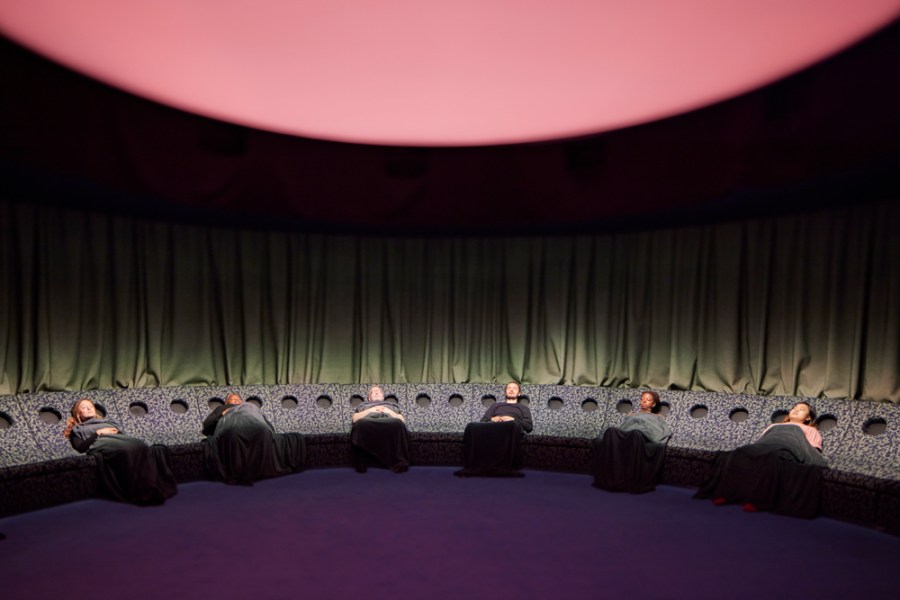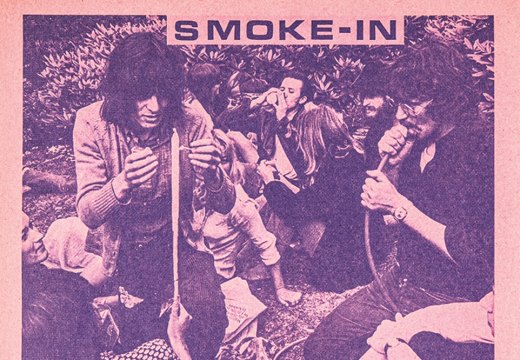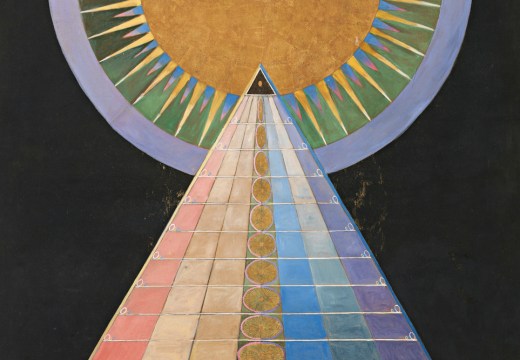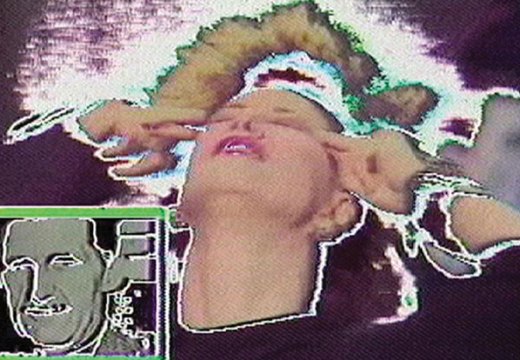Before visiting the Dreamachine, a psychedelic artwork-meets-wellbeing experience that exists in a category all of its own, attendees must first complete a form about their physical and psychological fitness. Do I find flashing lights and loud music overwhelming? Do any relatives have photosensitive epilepsy? Any sudden losses of consciousness, migraines, severe anxiety or psychosis to report? If there’s another art piece that requires such rigour as a precondition of entry, I can’t think of it.
All this is necessary to ensure a positive experience inside the Dreamachine, which has been created by participatory art producer Collective Act. In its most basic sense, this is a tent-like structure lined with comfortable recliners, where lights flash and a soundtrack by electronic musician Jon Hopkins plays, as visitors lie back with eyes closed. So far, so chill-out tent at Glastonbury. Where the magic really happens is inside your head, man. Relax into the experience – avoid scrunching up your eyes against the bright white light, near-painful even behind closed lids – and strange visions will appear against the blank darkness, synced to the pace and the pulse of the music. These sights are different for every person: no two experiences are the same, created as they are by the interaction between each brain and the strobe. Turn on, tune in and drop out – and if it all gets too much, an eye mask is on hand to make it stop.
The Dreamachine is, perhaps unsurprisingly, a product of the 1960s. It was the result of a collaboration between artist-poet Brion Gysin and electronics technician Ian Sommerville, who lived at the so-called Beat Hotel in Paris and was William S. Burroughs’ lover; you get the picture. After reading The Living Brain (1953) by neurophysiologist William Grey Walter, in 1961 the pair created the original Dreamachine: a perforated cylinder with a lightbulb suspended within, placed over a record turntable. As this rotates in front of expectant faces, eight to 13 light-flickers per second synchronise with the brain’s alpha waves (so the theory goes), causing images to appear behind closed eyes – no pharmaceuticals needed. As Salvador Dalí said: ‘I don’t do drugs. I am drugs.’
I have experienced Collective Act’s Dreamachine twice. The first time, intricate patterns melted between something like a Cosmati mosaic floor and the punctuated grids of a Welsh tapestry blanket. The next, it slipped between the jagged radiating lines of late-period Louis Wain and what looked remarkably like the iTunes Visualiser. Both times, patterns moved almost too fast to identify – let alone study – and coalesced around a central vanishing point, washed over by what looked like waves or television static. Complex geometries crystallised, morphed and vanished in a moment. It is an electrifying experience, and one that is impossible to share, though visitors are encouraged to record their visions through writing and drawing afterwards. These range from Hilma af Klint-like efforts to psytrance-esque patterns and hippyish pronouncements (‘We are specks of the smoke drifting infinite’).

One of thousands of drawings created by participants following their experience of the Dreamachine
As a curious teen, I tried a DIY version of Gysin’s original Dreamachine and saw precisely nothing. Thankfully, a young Jennifer Crook, now the founder and director of Collective Act, had more luck. It was this formative experience that inspired her, decades on, to create a fully immersive version. Finding funding took years, but Unboxed – formerly known as the Festival of Brexit – provided £10m to produce the project, which sold out across four cities (London, Cardiff, Belfast and Edinburgh). As a reviewer put it in the Guardian, it was ‘the one good thing to come out of Brexit’. When I visited its London showing last year, a huge derelict warehouse in Woolwich was filled with tables for drawing, stations for participating in a census on perception, areas to decompress, and of course the Dreamachine itself, created by the design studio Assemble.
The version I visited last week in Hackney Downs Studios in east London is a pocket-sized pilot, designed to test how a more modest version could work longer term. ‘My big vision is that there’s a Dreamachine on every high street – that you can go to a space of reflection as easily as to the bank or a shop,’ says Crook. ‘What if this was a practise people can have, like meditation or yoga?’ Collective Act have received 40-odd enquiries from cities around the world – next up is another show in the UK (details are yet to be disclosed), then tours of Europe and Australia in 2024. As we speak, they are hunting for a suitable London home for its first permanent location.
Will Crook’s vision come to pass? I suspect that it will – at least half. It is true that Dreamachine attendees often become evangelists for the experience, boring friends with their dream-like descriptions; many return for repeat sittings, citing feelings of wellbeing that follow their visits (these are the subject of an ongoing scientific study). I can see a future in which the invention becomes a fixture in major cities, rather like the IMAX cinema. Yet it is perhaps too strange, too hallucinogenic, for truly mainstream appeal. This would be a shame; there’s something uniquely cheering in knowing one’s brain to be capable of such beauty. Forget Van Gogh Alive, or whatever projection-based spectacle is the latest to come to town: this is immersive art in its truest, most worthwhile form.
Studio Dreamachine is at Hackney Downs Studios, London, until mid October.
Unlimited access from just $16 every 3 months
Subscribe to get unlimited and exclusive access to the top art stories, interviews and exhibition reviews.














![Masterpiece [Re]discovery 2022. Photo: Ben Fisher Photography, courtesy of Masterpiece London](http://www.apollo-magazine.com/wp-content/uploads/2022/07/MPL2022_4263.jpg)
It’s time for the government of London to return to its rightful home